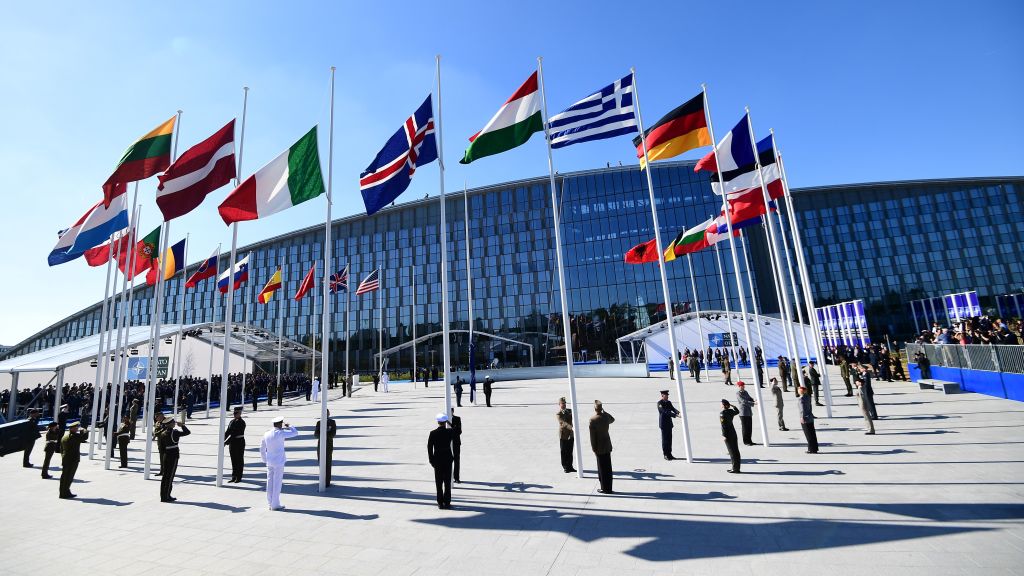Russia ‘s unprovoked invasion of Ukraine has sparked a heated debate about what US and NATO intervention should look like.
US officials have made it clear that the country’s troops will not clash directly with Russian forces. Additionally, NATO members have rejected calls to establish a no-fly zone in Ukraine , warning that it could lead to a “full-blown war in Europe.”
However, the situation could quickly change if Moscow’s attack on Ukraine were extended to a NATO member nation, triggering a response based on the alliance’s Article 5 principle.
But what exactly is article 5 and how does it apply to the war in Ukraine?
This is what you need to know.
What is NATO article 5?
Article 5 is the principle that states that an attack on a NATO member represents an attack on all the nations of the organization. This has been the cornerstone of the 30-state alliance since it was founded in 1949 as a counterweight to the Soviet Union.
The purpose of this principle is to deter potential adversaries from attacking NATO members. Article 5 guarantees that the resources of the entire alliance can be used to protect any member nation. This is crucial for many of the smaller countries, which would be helpless without their allies. Iceland, for example, does not have a standing army.
As the US is the largest and most powerful member of NATO, any state in the alliance is effectively under its protection.
According to the NATO website , Article 5 specifically states:
“The parties agree that an armed attack against one or more of them, which takes place in Europe or in North America, will be considered an attack directed against all of them, and accordingly, they agree that if such an attack occurs, each one of them, in exercise of the right to individual or collective self-defense recognized by Article 51 of the Charter of the United Nations, will assist the attacked party or parties, subsequently adopting, individually and in agreement with the other parties, the measures it deems necessary, including the use of armed force, to restore security in the North Atlantic area”.
“Any armed attack of this nature and all measures taken in consequence will be immediately brought to the attention of the Security Council. These measures will cease when the Security Council has taken the necessary steps to restore and maintain international peace and security.”
During the Cold War, the main concern was the Soviet Union. But, in recent years, Russia’s aggressive actions in Eastern Europe have gained attention.
Has article 5 ever been invoked?
Article 5 has only been invoked once: after the terrorist attacks of September 11, 2001 in the United States.
However, the principle of NATO Article 5 goes beyond attacks on national territory. The alliance has also taken collective defense measures on several occasions, including the deployment of Patriot missiles in 2012 on the border of Syria and Turkey, and the reinforcement of its presence in Estonia, Latvia, Lithuania and Poland after the annexation of Crimea by the from Russia in 2014.
NATO allies have also joined the US in fighting in Afghanistan, Iraq and Syria.
How does NATO Article 5 apply to Russia’s attack on Ukraine?
Because Ukraine is not a NATO member, the US is not obligated to protect the country in the same way it would if a NATO member nation were to come under attack.
But many of Ukraine’s neighbors are NATO members. So if a Russian attack were to spill over into one of those countries, Article 5 could trigger direct involvement by the US and other NATO members.
What exactly constitutes an attack on a NATO member nation?
The language of article 5 specifically notes that an “armed attack” against a member nation is what triggers collective action.
But what constitutes an “armed attack” is up to NATO members, and Russia’s aggressive stance has already raised concerns about the country’s willingness to potentially tempt a NATO response.
For example, Democratic Senator Mark Warner of Virginia recently told The Washington Post that a Russian cyberattack in Ukraine could have consequences beyond anticipated “geographic boundaries” and affect NATO members.
“It could end up hitting Poland or Romania or the Baltic states and cause damage that would shut down hospitals, and potentially, you have US troops there. If US troops in a truck crash because the lights didn’t work, you could get very close to Article 5,” warned Warner, chairman of the Senate Intelligence Committee, in a conversation with the newspaper.
Russia’s attack on the site of the Zaporizhzhia nuclear power plant, the largest in Europe, raised similar concerns. Although local authorities said “there has been no change in radiation levels” in the area, what if a radiation leak were to spread to a NATO member nation?
“That’s a question the alliance needs to ask,” Pentagon spokesman John Kirby told CNN earlier this month . “Specifically, I would just remember that Article 5 makes it clear that it is an armed attack against a NATO ally that triggers Article 5… But how that is interpreted… would really be something for the NATO alliance to determine.” “.
What are US officials currently saying about Article 5?
US Secretary of State Antony Blinken has reiterated the country’s and its allies’ commitment to NATO Article 5. In that sense, he stated: “If there is any aggression anywhere, in NATO territory, against NATO countries, we, the United States, all our allies and partners will take action to defend every inch of NATO territory. It is like this clear and direct.
The comments by the top US diplomat echo President Joe Biden’s promise during his State of the Union address to “defend every inch of NATO country territory with the full force of our collective might.”

